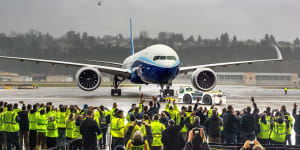This week Boeing’s chairman said he wouldn’t stand for re-election at Boeing’s upcoming annual meeting,its chief executive said he would and the head of the division that makes its commercial jetliners retired with immediate effect.

Airline CEOs are adamant that Boeing prioritise improving its quality control over any attempt to accelerate production.AP
While the CEO Dave Calhoun,a former chairman who took on the CEO role after the 2018 and 2019 crashes of Boeing Max 8 aircraft,said he would hang around until the end of the year,there’s already pressure from the company’s airline customers for more urgent change.
With the US Federal Aviation Administration already capping its production,a massive and growing backlog of orders and continuing quality control issues and safety incidents that have further slowed its production,Boeing’s plight is not just threatening its own financial condition – it expects net cash outflows of $US4 billion ($6.1 billion) to $US4.5 billion in the first quarter of this year – but is disrupting the entire industry.
While Boeing lost its mantle as the world’s largest commercial aircraft manufacturer to Airbus some years ago and the gap continues to widen,the two companies dominate commercial aircraft production. The industry will be – and is being – impaired by the problems within Boeing.
Already airlines in the US and Europe are having to revise their schedules to reflect smaller-than-planned fleets because of Boeing’s inability to deliver as promised. That’s against a backdrop of a continuing and new industry capacity in the post-pandemic environment.
That,in turn,will flow through,and is flowing through,to higher airfares as capacity is tightening relative to demand and – with the prospect of Boeing delivering the next generation of more fuel-efficient jets receding into the distance – more pressure on airlines’ costs in future.
Airlines from Ryanair to United,Qantas to Virgin,are having to re-think plans for their fleets,with Boeing’s delivery schedules now being stretched out considerably and having a significant question mark over them.
There’s no quick fix to the industry’s over-reliance on the two major manufacturers.
Airbus,which has a 62 per cent market share in the key narrow-bodied segment of the commercial market,is already struggling to keep up with demand despite ramping up its production.

Boeing’s under-fire CEO Dave Calhoun announced he will depart at the end of the year.AP
Last year Airbus delivered 735 aircraft,up from 663 in 2022,against Boeing’s 528. Airbus has a record backlog of 8598 jets and the highest gross orders (2319) in aviation history.
Boeing’s backlog of 6216 is swelling daily. It is likely that its order book will fall and its backlog of orders will grow further because of its current predicament.
Even though Airbus plans to deliver about 800 aircraft to customers this year it doesn’t have the capacity to pick up anything meaningful of the slack created by Boeing’s reduced production.
Boeing had planned to lift its own production to around 600 planes a year by 2025 but has suspended all forecasts after the January incident,when a fuselage panelfull of passengers.
Airbus,which earned about $US6.2 billion last year,is already investing in a successor to its very successful A320neo. It has said the new plane will be 20 per cent more fuel-efficient.
Boeing,having lost more than $US7 billion over the past two years,will likely fall further behind in terms of cutting-edge technologies because of the constraints on its ability to invest and the authorities’ – and its own – restrictions on production.
Boeing has slowed manufacturing rates as it grapples with quality control issues that pre-date the crashes of the two Max 8s.
A lot of Boeing watchers blame the 1997 acquisition of McDonnell Douglas for a shift in Boeing’s culture from one of engineering excellence and prioritisation of safety to the prioritisation of profits.
Pressure is mounting on Boeing in the wake of the Alaska Airlines scare,with loose bolts found in its 737 Max 9 jets.
Like many aircraft manufacturers,in recent decades Boeing has outsourced much of its production to focus on assembly. Airbus also relies on third-party suppliers – including Spirit Aerosystems,which was spun off from Boeing in 2005 and which makes Boeing’s fuselages – although perhaps to a lesser extent.
Its quality control issues were compounded by the pandemic. Where Airbus kept control of most of its workforce,Boeing let much of its go and has had trouble rehiring experienced workers as demand for its planes has rebounded.
Boeing has been in talks to buy back Spirit to regain direct control over the quality of production of a key source of some of its recent issues,which include the Alaskan Air incident,misdrilled holes on its 737 Max planes,loose bolts,tools found under cabin floors and,more recently, on a LATAM Airlines’ flight from Australia to New Zealand that injured 50 passengers.
Boeing has to sort out its quality control issues,not just to ensure its own survival,but because they will restrict the growth of the aviation industry and will increase airfares for customers if they aren’t resolved quickly,with consequences for entire economies.
The industry will – and is being – impaired by the problems within Boeing.
Beyond Airbus and Boeing there’s little relief in prospect for capacity-constrained airlines.
Embraer could possibly expand into larger aircraft but that would be a big and risky step up for the Brazilian company. When,in the last decade,Canada’s Bombardier tried to enter the smaller end of the markets dominated by Airbus and Boeing it was a disaster that ended with Bombardier largely exiting the mainstream commercial aviation markets.
China’s COMAC,whose C919 narrow-bodied jet flew commercially for the first time last year,,particularly in its home market,to Airbus and Boeing in the long term.
Its engine,avionics,control systems,brakes,wheels,tyres,landing gear and cabin system are,however,all made by US and European suppliers and it doesn’t have the ubiquitous international network of parts and service centres that the two dominant manufacturers have developed over many decades and which would be very difficult and costly to replicate in anything other than the very long term.
Airline CEOs are adamant that Boeing prioritise improving its quality control over any attempt to accelerate production. They don’t want unsafe planes or,as is happening today,passengers choosing not to fly on their Boeing aircraft. They want the next CEO to have a strong engineering background for that reason.
The candidates for that role will be few. There are few industries more complex or so reliant on such a complex ecosystem of suppliers and customers as aviation. The internal and external pressure on Boeing to make the right choice will be intense and the success,or failure,of the chosen one will influence the future shape of the entire industry.
The Business Briefing newsletter delivers major stories,exclusive coverage and expert opinion..